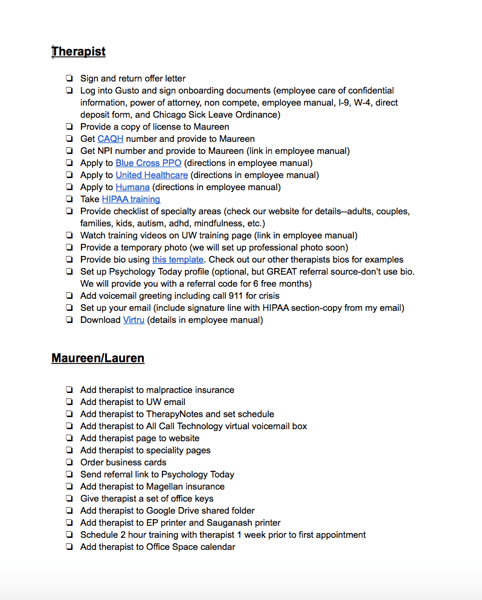5 Tips for Hiring and Onboarding Therapists at Your Group Practice
By Maureen Werrbach, LCPC on May 30, 2018


Whether you’re getting ready to hire your first therapist or your twentieth, the hiring and onboarding process can be stressful and time-consuming. Many group practice owners struggle to perfect the hiring process, which can lead to failed hires and stressed staff members.
Don’t worry: This is normal. Part of growing as a business owner is learning from your mistakes, becoming better at understanding your needs, communicating those needs to interviewees, asking the right questions, and being able to sense potential concerns. As your group practice grows, you’ll get better at this, but I’m here to help in the meantime.
Here are 5 tips for confidently interviewing, hiring, and onboarding your next therapist.
Interviewing and Hiring
1. Have a multi-step hiring process
Most group practice owners put an ad out, go right to an in-person interview, maybe check references, and then either hire or decline the candidate. One point of contact is not enough to accurately decide if someone is right for employment. You’re looking to find someone who can represent your business, and that takes at least 3 different points of contact before making your decision.
Additional points of contact may include:
- Having candidates answer important questions on a Google form, like why they want to work in a group practice, what their colleagues would say about them, and anything related to licensure, certification or availability
- Short phone interviews to go over non-negotiables and get a sense of their personality, to avoid wasting time on in-person interviews when they don’t meet basic requirements
- In-person interviews with one of your supervisors or support staff
- Peer interviews with your current therapists, to hear opinions of potential hires from a staff perspective
- Talking to references
2. Know your non-negotiables
One of the things group practice owners sometimes do is let go of their needs when they like a candidate. Therapists can sometimes feel empathetic and hire candidates who can’t work the number of hours you need or don’t have the desired certification, licensure or specialty. Know your non-negotiables. Write them down and don’t waiver. More often than not, group practice owners resent letting go of their non-negotiables later. A candidate that fits ALL your practice’s needs is out there. Keep looking.
3. Be transparent during the interviewing and hiring process
If this is your first hire, let them know that. Tell them they’ll be an active part in creating the culture of the practice. Don’t pretend to be anything other than what your practice currently is. Don’t offer things you can’t give. Tell them what you expect. Tell them what they should expect about growing their caseload or income before they’re hired. The more transparent you are now, the less bitter they’ll be later.
Onboarding
4. Put together a step-by-step, interactive to-do list for both the new clinician and practice
What this does is hold both you and the new therapist accountable for doing the required onboarding tasks. Often, group practice owners and new clinicians spend more time than necessary going back and forth via email to check in on the status of various tasks. A checklist that holds both parties accountable without the need for constant check-ins is a great antidote. This also helps let the new clinician know what tasks should be done first.
Below is a copy of my practice’s onboarding checklist, to give you an idea:

5. Start a video training page that shows clinicians how to do practice-specific tasks
Having a page dedicated to training videos can help your new therapist’s onboarding experience and reduce wasted time. Some examples of videos include:
- How to use your practice’s EHR
- How to set up email and virtual voicemails
- Taking payments
- Anything else specific to your practice
Whether it’s a video or some other medium, training is crucial. In fact, did you know for every 20 minutes of work, your clinician will need 2 hours of training? That’s right. Research has shown that businesses spend much less time than they should training their employees. Then they get frustrated when staff members don’t follow through on tasks or forget things. Spending the extra time training new hires sets the precedent for a positive work environment.
Following these tips will make interviewing, hiring, and onboarding much easier, leaving you more confident in your decisions and your staff.
* The content of this post is intended to serve as general advice and information. It is not to be taken as legal advice and may not account for all rules and regulations in every jurisdiction. For legal advice, please contact an attorney.
About Maureen Werrbach, LCPC
Get more content like this, delivered right to your inbox. Subscribe to our newsletter.
More Content You'll Enjoy
The Best Practice Fusion Alternative for Mental Health

Supercharge your Documentation with TherapyFuel!
